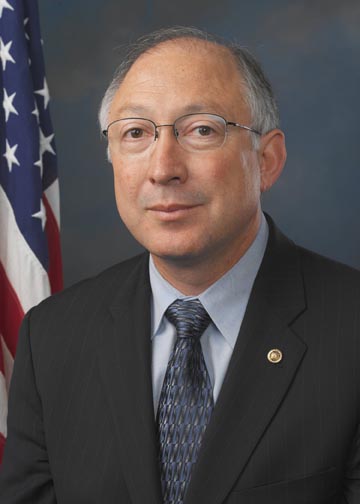
Interior Secretary Ken Salazar
WINDOW ROCK, ARIZONA –– Reliable, clean water will soon be available to the Navajo Nation where 40 percent of families haul their water in barrels from pumping stations. The Department of the Interior has awarded a $10.7 million contract to McMillan LLC of Boise, Idaho to start the first phase of the Navajo-Gallup Water Supply Project which includes four miles of pipeline and a substation near Twin Lakes and Gallup, New Mexico. It will supply water to the Navajo Nation, to parts of the Jicarilla Apache Nation, and the city of Gallup. And, there are more phases to come. When completed, the entire $1 billion project will include 280 miles of pipelines, several pumping stations and two treatment plants. It will supply clean water to the entire Navajo Nation - 27,000 square miles spanning parts of Arizona, New Mexico and Utah and home to more than 200,000 people. “These areas rely on rapidly depleting groundwater of poor quality that is inadequate to meet current and future demands,” said Secretary of the Interior Ken Salazar in a press release. The first phase of the project will improve on the present pipeline which draws water from underground aquifers. The water system will eventually pump and treat water from the San Juan River basin. The first water delivery to the Navajo communities could occur in two to three years, said Salazar. Further portions will be constructed by the city of Gallup, the Navajo Nation and the Indian Health Service with financial assistance agreements with the Bureau of Reclamation. The project is expected to create 400 to 600 construction jobs, depending on the phase of the project. “The permanent water supply will vastly improve the quality of life and offer greater economic security for the Navajo Nation,” Salazar said. “The project is one of 14 high priority infrastructure projects identified by the Obama Administration to be expedited through the permitting and environmental review process.” The Department of the Interior, the Jicarilla Apache Nation, the state of New Mexico and the Bureau of Indian Affairs are contributing to the project. Gallup and the Jicarilla Apache tribe have a repayment agreement with the federal government. In December, 2010, Salazar signed the Navajo Nation San Juan River Basin Water Rights Settlement authorizing the project which is to be completed by 2024. It will provide 37,376 acre-feet of water annually from the San Juan River Basin. The pipeline project is one of many stemming from Public Law 111-11 the Omnibus Land Management Act legislation passed by Congress in 2009 which settled Navajo water rights claims in the San Juan River Basin. The legislation which included this project also awarded water projects throughout the United States. In addition to the Navajo and Jicarilla Apache tribes, the White Mountain Apache, the Aamodt, Taos Pueblo and other tribes also received water projects stemming from the bill, said Jason John, manager of the Navajo Nation Water Management Branch. “The Navajo Nation is getting a renewable water supply. It will allow for economic development in a lot of communities,” said John. “It’s huge, one of the first of its kind for the Navajo Nation. We’ve not had a project this large on the Navajo Nation. It’s the first one coming through. Life will be a lot different for a lot of folks.” Legal and technical experts from the Navajo Nation including water rights attorneys sat down with state and federal officials in the past to discuss water rights, John said. Tribal and state officials met with New Mexico and Arizona congressmen along with the Bureau of Indian Affairs, the Bureau of Reclamation, and the Department of the Interior. “Our congressmen sponsored bills and got them through Congress. It required strong congressional representation,” including senators Pete Domenici and Jeff Bingaman in New Mexico and John Kyl in Arizona, said John. Pat Page, an engineer for the Four Corners Construction Office of the Bureau of Land Management in Farmington, New Mexico, said the present ground water system “is of poor quality and there’s a limited quantity. It is not always replaced. Now, there will be reliable higher quality water.” The first phase of the project will improve on the water system already in place. Next, river water will be diverted which could take eight to ten years. More contracts will be awarded in the Fall. “It’s about bringing water to the people. My staff believes that the Navajo Nation sees this as a huge opportunity. It’s more than water to households. It’s also water for hospitals, schools and businesses. Water is life. It will have a huge, huge impact on the people there. It will be treated, reliable water.” The project has been discussed for decades, Page added. “It’s a big project. It took time to get support.” President Obama saw this project as one of 14 top priorities because “environmental compliance was completed, it had a reasonable assurance of funding and it had a great potential for job creation.” “It’s a billion-dollar project. It’s a big one. We’re excited to reach the first phase. We look forward to working with this contractor to get it going. I’m excited. This is a project for all the right reasons.” Added Lisa Iams, public relations specialist for the Bureau of Reclamation, “there will be considerable change. It will have a very positive effect on the economy and job creation. The system is primitive now. It’s a drum in the back of a pickup truck.” (Kate Saltzstein can be reached at salty223@aol.com)
Join the Conversation
